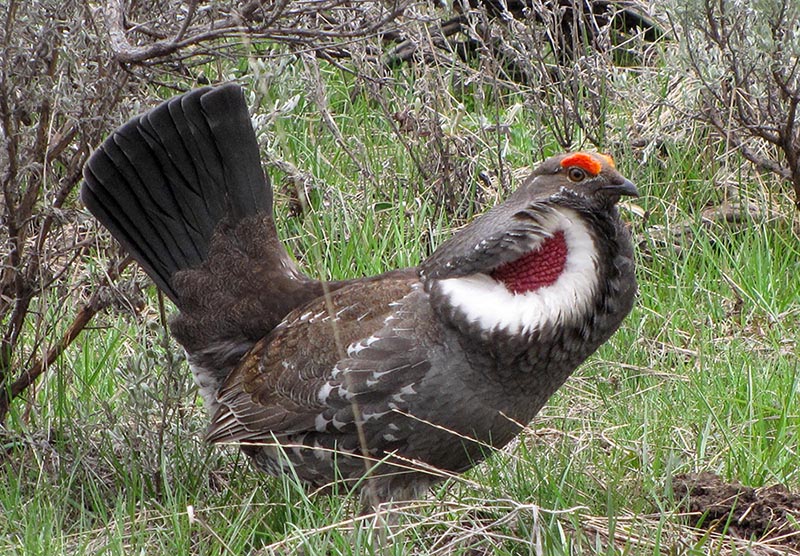
The Dusky Grouse (Dendragapus obscurus), also known as the Blue Grouse, is a medium-sized bird that can measure up to 12-15 inches long and is found in the Rocky Mountains in North America.
Its unique plumage and elusive nature make it a sought-after game bird for hunters and a fascinating subject for birdwatchers.
It is considered to be a common bird species in its range.
On this page
Is a Dusky Grouse the same as a Blue Grouse?
Previously, Dusky Grouse (Dendragapus obscurus) was known under the name of Blue Grouse together with another, very similar species called Sooty Grouse (Dendragapus fuliginosus).
Dusky Grouse and Sooty Grouse were first identified separately in the 1800s, but in the 1900s were combined into one species called the Blue Grouse.
In 2006, Blue Grouse was once again divided into these two species based on differences in their DNA. The species look very similar at first glance, and they prefer the same habitats, sometimes overlapping in range and then interbreeding. However, there are ways to identify which is which.
Firstly, Dusky Grouse prefers the drier eastern side of the mountain ranges, whereas the Sooty Grouse usually goes for the moist mountain forests of the Pacific Coast.
The easiest way to identify them on the field is by looking at the color of the air sac on their neck. If it’s red, then it’s a Dusky Grouse, and if it’s yellow, then it’s a Sooty Grouse.
Sooty Grouse also has darker black plumage. The females of both species are nearly identical and are almost impossible to tell apart in the field.
Identification
Male

Copyright: Jane Olson @ Flickr
Male Dusky Grouses are generally larger than females, but they look fairly similar when breeding season isn’t ongoing. Their plumage is slate gray with white in the mix and they are generally larger than females.
Males have a prominent gray band along the tip of their tail feathers and yellow-orange eyebrows that turn red during mating season. They also have a red air sack at the base of their neck, which they display during mating rituals.
During the breeding season, male Dusky Grouse calls with a series of very low-pitched and quiet hoots that a human can barely hear. When confronting an intruder, you can hear a gravelly gugugug or a clear cak-cak.
Female Dusky Grouse
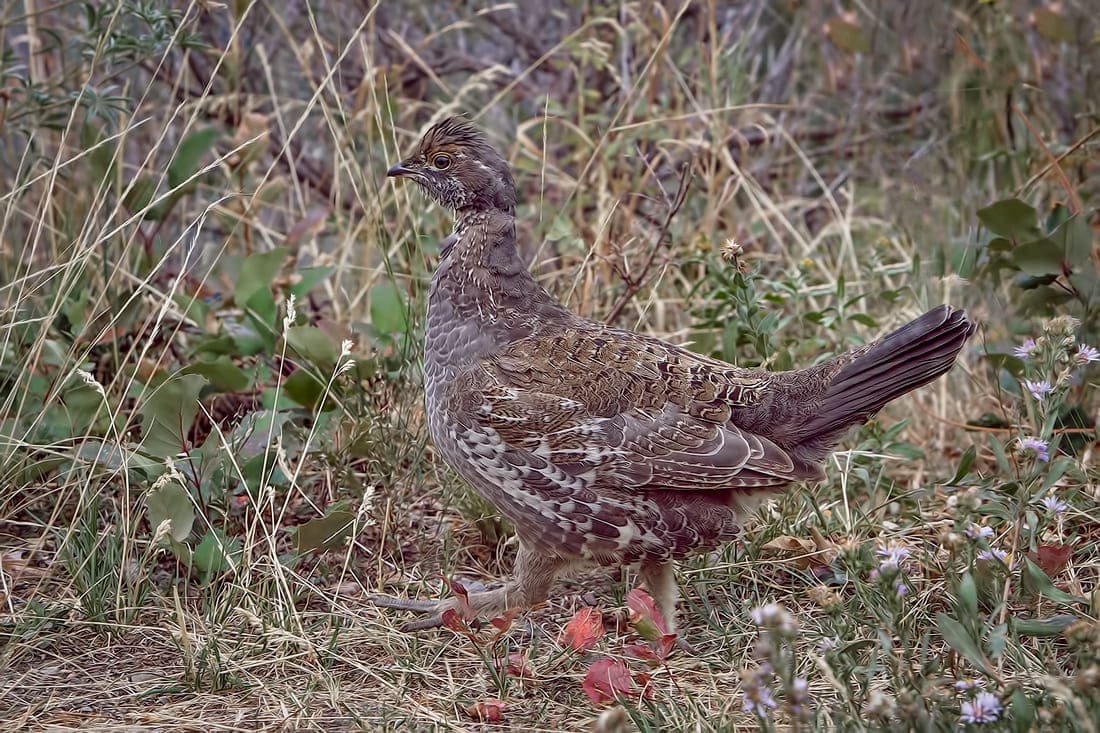
Female Dusky Grouses are more greyish-brown mixed with white. They also have a gray band running along the tip of their tail feathers, but it isn’t as visible because they don’t tend to fan out their tail. The inner corner of their eye is dull yellow. Overall, they’re a bit more modest and lack the colorful embellishments their male counterpart has.
Female Dusky Grouses sound quieter, giving hesitant cackles when showing interest in males, but they are known to hiss or cluck when being aggressive. They give quiet and soft tu-s to their young and if separated from them, they call with loud, high-pitched skree-s and kwa-s
Diet
Dusky Grouses are mainly herbivores, but they also feed on insects. During summer they forage on the ground, but high up in conifer trees in the winter. They like to eat a hefty meal early in the morning and then at dusk. Like many other birds, they rely on small grains of stone in their gizzard to grind up the food.
During summer, they feed on berries, such as blueberries, cherries, currants, hawthorn, and gooseberries, and other plant material, such as shoots, buds, and leaves from plants such as buckwheat and clover. Their diet also includes a variety of insects, their favorite being grasshoppers.
During the winter they like to perch on conifer trees and feast on their needles and buds, and seeds from the cones the trees produce. They can be seen on different firs, such as Douglas-fir, white fir, noble fir, grand fir, but also hemlock, and pine trees.
Young birds also add ants and other small insects into their diet.
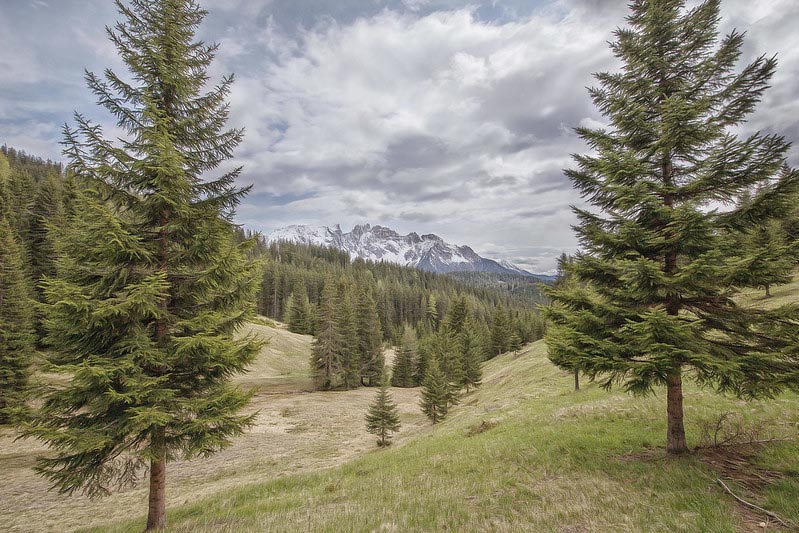
Dusky Grouse can be seen on different firs, such as Douglas-fir, white fir, noble fir, grand fir, but also hemlock, and pine trees.
Nesting and Eggs
Dusky Grouse males initiate breeding by hooting. They claim and defend a territory by fanning out their tail feathers, hopping, revealing the red air sack on their neck, and flapping their wings. The males can either gather in an area to challenge other males for female attention or go out in search of a female on their own.
After breeding, the females are on their own. They build their nest on the ground under something that provides cover from the elements, such as in a shrub, or under a fallen log or rock ledge.
The nest is built away from the territories of males and other nests. It is a shallow scrape in the ground, lined with materials such as small twigs, leaves, needles, moss, bark, and feathers.
The female then lays 1-12, on average 5-10 light beige or pale white eggs with small brown speckles that are about 2 inches in length and 1.3-1.4 inches wide.
They take 25-28 days to incubate. The Dusky Grouse chicks leave the nest within a few days and keep close to their mother. The mother protects them while the chicks find their own food. After about 10-28 days, the chicks begin to separate from the mother, although she still keeps an eye on them.
Current Situation
Dusky Grouses range in the western mountains of North America, such as the Rocky Mountains and the Black Hills. They can be seen from southeastern Alaska to the southern United States. Dusky Grouses are permanent residents within their range, but they move short distances during different times of the year.
During the breeding season, Dusky Grouse habitats are mountain forests dominated by firs, pine, and aspen. In the summer, they prefer to move downward and can be found in the surrounding grasslands and low-lying areas rich with berries, but also in high-elevation alpine meadows. In the winter, they remain near the tree line at high elevations, roosting in firs and pines.
Dusky Grouse is a common bird within its range and hasn’t experienced a big decline in numbers. It’s listed as being of least concern in the IUCN Red List.
However, the bird has a relatively short lifespan of 4-12 months, although it can live up to 14 years old, and this is due to being a source of food for many predators both aerial and terrestrial, and being a popular game bird for humans.
Facts
- Unlike most birds and animals, they move to higher-elevation forests for the winter. This is because there are fewer predators and more food.
- Unlike most birds, which have a specific number of tail feathers, the Dusky Grouse can have anywhere from 15 to 22.
- The male Dusky Grouse has a unique mating display, where it will puff up its chest, spread its tail feathers, reveal its red air sac, and stomp its feet to attract a mate.
- In Native America, Grouses symbolize justice and revenge. In general, they’re a symbol of defense, self-preservation, and survival.
Similar Species
There are 3 similar species to Dusky Grouse, all of them being Grouses. But don’t worry, there are some easy tells to separate them.
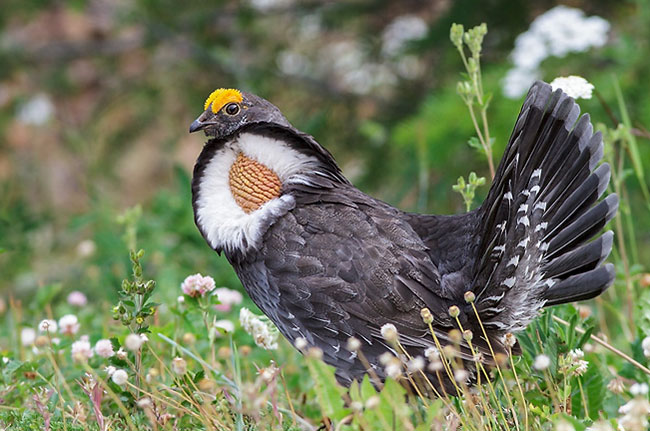
Sooty Grouse
Sooty Grouse – The range of these birds overlaps mostly in British Columbia.
In that area, the Sooty Grouse’s tail tip has a gray band, whereas a Dusky Grouse’s tail is all black. Apart from that, a male Sooty Grouse has an orangish-yellow neck patch compared to Dusty Grouse’s red.
Females, however, are almost impossible to tell apart in the field.
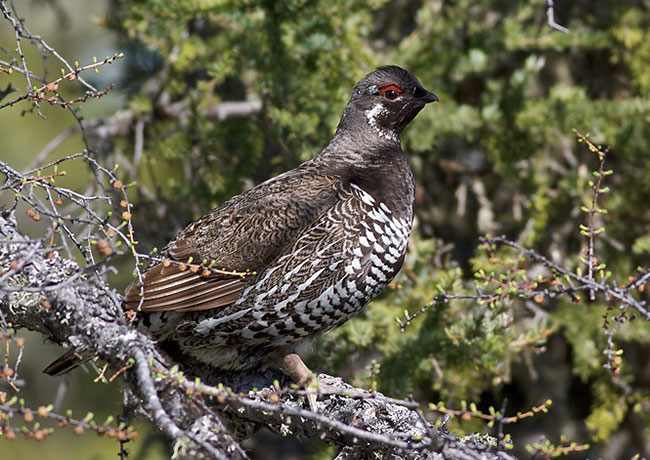
Spruce Grouse. Photograph © Glenn Bartley
Spruce Grouse – Male Spruce Grouse is smaller than a male Dusky Grouse and are black with more white spots on their breast and belly instead of mostly gray overall.
Dusky Grouse’s tail is usually black and lined with gray on the top, but a Spruce Grouse has a tail tipped with brown. The female Spruce Grouses are also smaller and have shorter tails, they have more white and a clearer barring on their underside.
Spruce Grouse’s eyebrows are red, whereas Dusky’s are usually yellow and red only during the breeding season.
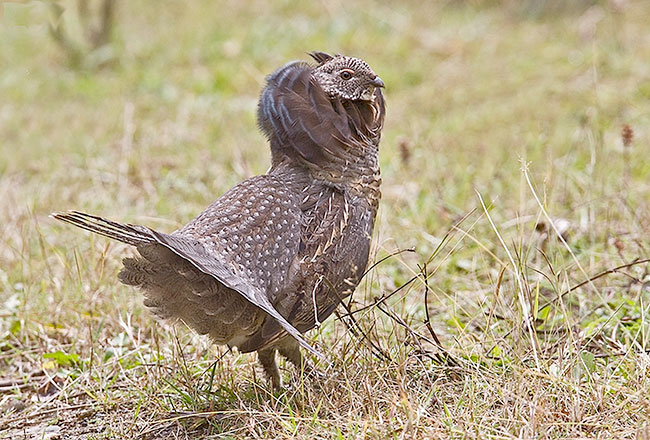
Ruffed Grouse. Photograph © Alan Wilson
Ruffed Grouse – Male Ruffled and Dusky Grouses are a bit easier to distinguish.
Ruffled Grouses are smaller and have lighter coloring. Their tail is light brown and has a dark brown band near the tip.
Unlike Dusky Grouse’s red air sac on the neck, the Ruffled Grouse fluffs up dark feathers around its neck.
Ruffled Grouses also have a short crest and dark bars on their whitish sides and belly, whereas a Dusky Grouse has a more slaty-gray plumage all over.
FAQ
What is a Blue Grouse called now?
Blue Grouse has been divided into two species, Sooty Grouse and Dusky Grouse, of which the latter obtained its scientific name.
How big is a Dusky Grouse?
Dusky Grouse grows up to 12-15 inches long, has a wingspan of 24-28 inches, and weighs around 2-3 pounds. It is the 3rd biggest Grouse in North America.
Are Dusky Grouse rare?
Dusky Grouses are common within its range and listed as Least Concern in the IUCN Red List. However, you might have trouble meeting one as they blend well into their surroundings.
